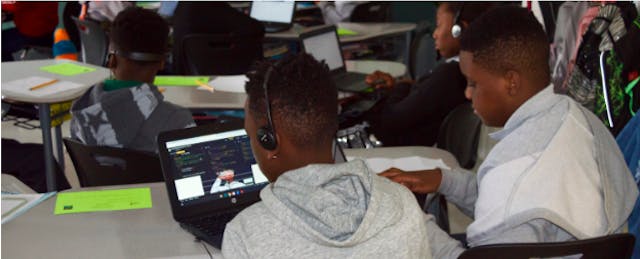WASHINGTON, D.C. — It was Spirit Week at the Digital Pioneers Academy, and in fitting with the day’s “sports” theme, Mashea Ashton, the school’s founder and principal, had arrived wearing a red-and-white Devante Smith-Pelly jersey.
Ashton’s decision to don this particular jersey—that of a local celebrity, a Washington Capitals hockey player and Stanley Cup champion—was not made lightly, and she wanted her middle schoolers to know why.
“What does he have in common with you all?” Ashton asked students that morning. He’s black, some replied. He’s unusual, another suggested. (Smith-Pelly is one of about two-dozen black players in the National Hockey League.)
“No, it’s not that he’s black and he’s rare in hockey,” she explained. “It’s because he’s so good they can’t ignore him, and you all have to be so good that people can’t ignore you.”
Ashton wasn’t talking about the students’ athletic prowess. She was talking about computer science—the subject at the core of the middle school she founded in Southeast D.C. last fall.
Computer science-focused schools are not so rare anymore. Neither are those that mention “innovation” and “21st century skills” in their mission statements. But the Digital Pioneers Academy does those things while serving a student population that is 100 percent black and Latino—two underrepresented demographics in computer science education and the workforce.
“I think until you see it, until you see 120 African American and Latino students building websites, creating games, creating apps,” it’s hard to capture the “tremendous potential” that the school is harnessing, Ashton said during EdSurge's visit to the school earlier this month. The computer science curriculum is doing more than teaching underserved middle school students how to code. It’s also boosting their confidence and empowering them to think big about their futures.
The Seed of a School
When Ashton, a New Jersey native, moved to D.C. three years ago to be closer to family, she continued to do the work she had started years earlier at the KIPP Foundation, the New York City Department of Education and the Newark Charter School Fund—improving the quality of urban education across the country. But she felt the greatest contribution she could make to the city was to provide a high-quality school option, specifically for low-income families living in some of D.C.’s most economically disadvantaged neighborhoods: east of the Anacostia River, in Wards 7 and 8.
At first, she planned to start a college preparatory school, “but then I thought of all these experiences that I have with students and families,” she said. “Our scholars need college prep, but they also need real jobs. Jobs are going to help break the cycle of poverty that so many of our scholars experience.”
Around that time, Ashton read about the high demand for skilled workers in computer science—a growing field that offers high-paying jobs, with a starting salary around $65,000 per year. According to that article, there would be 1 million unfilled computer science jobs by 2020, based on estimations from the U.S. Bureau of Labor Statistics. And that was it; Ashton decided the school would be built on a foundation of computer science.
“Our mission is just to develop the next generation of innovators,” she explained. “We want our scholars to not just consume the digital economy, but be a part of creating it.”
After surveying nearly 200 families in the community to gauge their appetite for computer science education, Ashton and a few founding members of the Digital Pioneers Academy began going around to elementary schools in Wards 7 and 8 telling them about the new middle school that was opening its doors in fall 2018 to the first class of sixth grade students.
To support their efforts, they enlisted unusual help: from a robot named Meccanoid. Red and white and standing nearly four feet tall, Meccanoid can be programmed to move and talk about a wide range of topics—including the Digital Pioneers Academy.
“We took the robot and we said, ‘Hey, do you want to be part of the founding class where you learn not just how to play with Meccanoid—and he talks and he does lots of fun things—but you get to create and build a Meccanoid?’” Ashton recalled.
Even then, when she was visiting traditional public and charter schools in the area, she had little more than the school uniforms picked out. She didn’t even have a building for the new school, she said. And yet, after visiting classrooms and talking with students about her vision, she’d return home at night to messages from parents saying they were in—they wanted to enroll their child at the Digital Pioneers Academy.
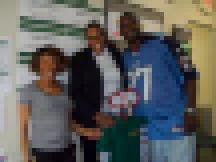
Diving into Year One
Ashton eventually found a home for the school in a wing of the East Washington Heights Baptist Church, located east of the Anacostia, on Branch Avenue. In August 2018, Digital Pioneers Academy opened its doors to 120 sixth-graders.
The public charter school provides every student with a Chromebook and purchases licenses to online curricula for subjects including English language arts, math and computer science.
At Digital Pioneers Academy, students spend one hour a day, five days a week, in computer science class. They spend another 30 minutes a day, four days a week, taking robotics. In the nine months since the school opened, students—the majority of whom had no coding experience—have progressed from using simple block-based programming tools to now writing code in HTML, CSS and JavaScript.
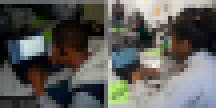
An expressed goal of the school, Ashton said, is to have 100 percent of students pass the AP Computer Science Principles exam by the end of 10th grade. “We believe that’s going to give them the maximum opportunity and maximum choices for colleges and universities, for careers, for community college—for whatever they decide,” she said.
In early May, students were finishing up a website design unit in their computer science class, which follows the curriculum designed by RePublic Schools, a charter school network based in Nashville, Tenn. The curriculum, which is aligned to the AP Computer Science framework, is free, but teacher training is not.
The final project of the website design unit required that students build a website around a trivia game, explained Trenisha Goslee, a STEM teacher at Digital Pioneers Academy. Goslee herself created a website featuring “coffee mug trivia” because she collects coffee mugs, while students did theirs on a range of topics, including candy, sports and “about me.”
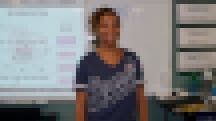
“Being able to learn to code and learn stuff high school students and college students are just beginning to learn—it’s a great opportunity and they really enjoy it,” Goslee said. “It’s instant satisfaction. They’re coding, and right next to it they can see in real-time what they’re creating.”
Last fall, students in Goslee’s class learned to code on Scratch, the MIT-developed, block-based programming language designed for children. Then they transitioned to more advanced coding languages.
“Some of the students, like Senora, just went above and beyond,” Goslee added.
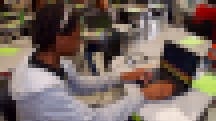
Senora Akoma’s trivia game was themed around Digital Pioneers Academy. After she completed the project requirements, Senora went home and continued to build out her website, altering the background colors and testing out different fonts.
“I see all these websites, and I was able to create my own,” she explained. “Seeing my own creation is cool.”
Before she came to Digital Pioneers Academy, Senora had a tough time at school, Ashton said. In elementary school, she was bullied, and girls often started fights with her in the bathroom, pulling her hair and calling her names. She hated it.
“There’s no bullying here,” Senora said. “People are actually here to encourage you. People tell you, ‘You can do it,’ and you actually start to believe it. And then you do it.”
Aside from learning how to code, Senora also found opportunities to step into a leadership role at her new school. She said she used to be afraid of public speaking and campaigning, but the school helped her face her fears. Now, she’s the vice president of her class.
Scaling the School
Come this fall, the student headcount at the Digital Pioneers Academy will double as the current pupils move on to seventh grade and 120 new sixth graders enroll. As a result, the school will outgrow the Baptist church that now houses them.
Ashton has found a vacant high school to which her students and staff can relocate, and while it’s a good option in Southeast D.C., she said, it’s on the other side of the Anacostia River—a distinction that is symbolic to many families in the community. Instead of being around the corner from many of their homes in Ward 7, where the median household income is $40,000, the school will soon be situated in Ward 6, near the U.S. Capitol and the rapidly gentrifying neighborhoods that surround it. There, the median household income is $102,000.
“Logistically, it’s only a three-minute longer commute for all of our kids,” Ashton explained. “But psychologically, having to go across the river is unfortunate. They should be able to stay in their community and have access to a quality option, but we couldn’t find a building [here] that would allow us to grow.”
The good news is that, in spite of the relocation, still 185 families applied for just 120 spots in the new sixth grade class. Digital Pioneers Academy is building a reputation in the community it serves, and families increasingly want to be a part of what’s happening there.
Ashton’s dream, she said, is to fine-tune the Digital Pioneers model in D.C. then scale it to 20 or 25 other urban areas in the United States. She wants children in all corners of the country to learn what it took her decades to find out, what the 120 students in her D.C. school are beginning to understand: That where you were born and what you look like doesn’t determine how smart you are or how successful you can become.
